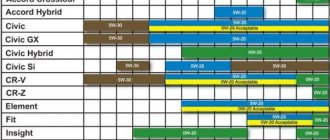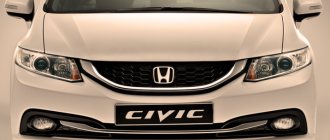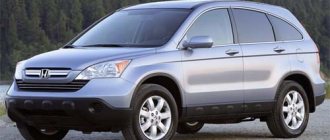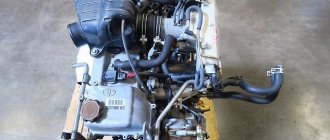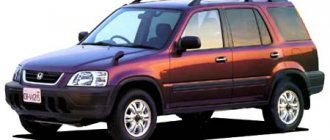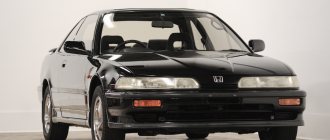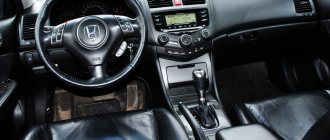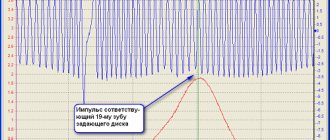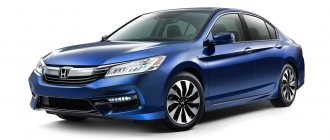Honda Civic VI generation (1995-2001)
The sixth generation Honda Civic may come not only from Japan, but also from the USA and Great Britain. Moreover, the latest versions are so different that at first it’s even difficult to believe in the “authenticity” of the English Civic.
History of Honda Civic V generation 1991-1995. 02.95 Debut of the next generation of the model 09.97 Production of 5-door hatchbacks began. Installation of a 2.0-liter turbodiesel and 1.8-liter gasoline VTEC 01.90 Restyling of English versions. Start of the Aerodecfc station wagon 01.99 Facelift of the Japanese version of the Honda Civic VII generation 2001-2005.
BODY
But there is still no need to doubt – this is a real Civic. The “two-facedness” of this model is explained quite simply - the whole point is that the Japanese have launched in their homeland the production of only 3-door hatchbacks and 4-door sedans of the sixth generation Civic with the characteristic large, “big-eyed” front optics. But in England, only 5-door hatchbacks and Aerodeck station wagons (rare) were produced. The different appearance of the “English” is due to the fact that the design of the Honda Domani, produced exclusively for the domestic Japanese market, was taken as the basis for it.
Despite the fact that in 2001 the production of the sixth generation Civic was discontinued everywhere, the car continued to roll off the assembly line... Although from a different plant and under a different name: the Civic has “doubles” - the Rover 200 series and the Rover 400 series. Outwardly, they bore little resemblance to their ancestor, but their technical components are very similar, so branded service stations service both Honda and Rover models without any problems.
In the sixth generation Civic, the passive safety of the car was significantly improved - it was provided with a built-in protective frame, and all officially imported models were equipped with front airbags. Thanks to galvanization, the body is reliably protected from corrosion.
SALON
The Japanese and English versions differ significantly in interior design. In addition, the “English” have better sound insulation. All Civics have a low driving position for the sake of the model's sporty image. The ergonomics are not satisfactory, and visibility is limited by the elevated rear only in the 4-door sedan when reversing. A typical problem for cars with mileage over 200 thousand km is clogging of the air conditioner radiator honeycomb.
ENGINES
Civic petrol power units with motorcycle racing pedigree are a source of special pride for this brand. All of them are 4-cylinder, 16-valve and high-speed. That’s why it’s nice to spin them until they ring. At the same time, the motors reliably withstand such harsh operation.
Let us pay attention to another feature of these engines - they are arranged in the engine compartment “topsy-turvy”: the gearbox is located on the right side of the car, and not on the left, as in other “front-wheel drive” vehicles with a transverse engine arrangement.
Many units were equipped with the proprietary VTEC variable valve timing system. which, depending on engine speed, changes the height and opening time of the valves. Due to this, high torque is achieved almost from idle engine speed and high power. An example of this is the “charged” VTi modification with a 1.6 liter 2-camshaft engine with a capacity of 160 hp. With. We don’t see such versions too often, and besides, their owners are in no hurry to part with their “favorites.” However, do not be mistaken in believing that all VTEC engines have a sporty character. The 16-valve 1-camshaft units with a volume of 1.5 liters (114 hp) and 1.6 liters (126 hp) are equipped with VTECE tuned for economical driving.
Please note that all units, especially VTEC, require the use of high-quality synthetic oil and its timely replacement. Otherwise, the oil channels may become clogged, which will lead to failure of the variable valve timing system. By the way, due to the use of this complex system in the gas distribution mechanism, the designers abandoned the hydraulic valve clearance compensators installed by many automakers. Therefore, every 40 thousand km you will have to adjust the valves in the old fashioned way at a service center.
The specialists were unable to fix any faults typical for Civic readers. Everything works reliably and for a long time. But it’s very difficult to say anything about turbodiesel versions equipped with 2.0-liter Rover engines, since they are rare.
TRANSMISSION
Most Civics are front-wheel drive cars equipped with a 5-speed manual transmission; less common are versions with a 4-speed automatic transmission, and the greatest rarity is a Civic equipped with a V-belt CVT.
Civic gearboxes are very “patriotic” - for reliable and durable operation they must consume only Honda branded oil. The 5-speed manual gearbox requires MTF-2 lubricant. which is recommended to be changed every 80 thousand km. The hydromechanical automatic transmission requires special transmission oil ATF Z1, and the variator requires ATFCVT.
Service workers do not recall cases of repair of automatic transmissions, but problems may arise with manual transmissions after 400 thousand. Usually. By this time, the gearbox bearings fail. This malfunction can be determined by the hum when the gearbox is operating.
In addition, in high-mileage vehicles, the hydraulic clutch cuffs may leak. The cost of replacing them is the same - S20. but the prices for the parts are different - the cuffs for the clutch slave cylinder are supplied as a separate spare part, and for the main one - only assembled with the piston.
SUSPENSION
The Civic's chassis has excellent stability and is a rare combination of good ride quality and amazing durability. The only complaint about the car is its low ground clearance (110 mm).
The independent suspension of the front and rear wheels provides enviable grip when driving at high speeds. Serious repairs, as a rule, are required only after 200 thousand km. This does not apply only to the “rubber bands” of the anti-roll bars. Front stabilizer bushings last about 50 thousand km. rack - up to 100 thousand km, and rear - slightly longer. All silent blocks and “ball” blocks are changed separately from the levers, except for the upper ball joint. On cars with a mileage of more than 300 thousand km, it may be necessary to replace the rear bearing, which is supplied only assembled with the hub.
STEERING
The steering mechanism with a large gear ratio is not very suitable for the car for active driving - there are almost four turns from lock to lock. At the same time. despite the hydraulic booster. The reverse force on the steering wheel feels great.
BRAKE SYSTEM
The brakes do not cause any notice - even versions with rear “drums” provide excellent deceleration. and in powerful modifications with all disc mechanisms, the brakes are generally “dead.” The ABS system, found on many cars, also contributes to their efficiency.
The purchase of a Honda Civic can be recommended to young people who drive mainly in the city and prefer an active driving style - after all, even cars with low-power engines have acceptable dynamics and good stability.
ADVANTAGES AND DISADVANTAGES
+ High passive safety. Reliable and dynamic engines. Good smoothness. Excellent stability. Efficient brakes
– High cost of vehicle maintenance. Poor sound insulation (Japanese and American versions). Small ground clearance. Small trunk
Diseases of Honda Civic 6th generation
Random article learn something new
Introduction
An article about diseases of the Honda Civic EJ9 will be useful to both future owners and owners of the Honda Civic in the EJ9 modification in the following bodies: hatchback, sedan and coupe. First of all, let me remind you that the 6th generation Honda Civic was produced from 1996 to 2001. In 1999, “restyle” appeared, or better said “facelift”. At the time of writing, it is 2011, which means that the oldest cars are already 15 years old. I think it's worth thinking about your desires to buy the perfect car that has never been in an accident. The price category at the moment is 150,000-230,000 rubles (about $7,000). Over time, there are fewer cars, and even fewer living cars. The D14A4 and D14A3 engines with 75 or 90 horsepower engines, which at a certain time were not chosen by hot young people, but were chosen by a 1.6 car with a VTEC system, remain such “Zhivochik” engines. Even from personal experience, these engines are already tired, no, they are not dead, Honda engines of the 4.5 and 6th generations are generally difficult to kill, but you will have to pour more money into it than into a car with a heart of 75-90 hp. It’s just that a person owning such a car did not often squeeze out all its resources shouting “VTEC just kicked in YOOOO!” So it turns out that both the suspension and the engine are already tired. As for the torsion of mileage, well, who knows, they can calculate with an average mileage of 13,000 per year how much it should be. Again, there are exceptions, so I now have a car with 150,000 miles on it, and I drove 25,000 in 4 years (at the time of 2011, in 2012 177,000). I will also say that the article contains more negative aspects, and none of the advantages of the car. I tell you the advantages in articles on repairs, and the army of thousands of owners of this car will also tell them with a smile on their faces. You decide. Well, if you already own a car, then it’s time to think about setting up and tuning the Civic.
I know all the mistakes, but I won’t tell you them - former owner
Body
The most painful places are the rear of the body; the body is the biggest problem with the Honda Civic. Particular attention should be paid to the rear arches, the places where the bumpers are attached, and also the inner part of the arches wing. Rust attacks metal without proper arch liners. The second body disease is rust under the spare tire in the trunk. Water flows down the trunk rails or taillights to the bottom of the trunk, where the water stagnates and remains due to clogged drain holes. It is treated by cleaning the drains and sealing the gaps of the rear lights. In terms of paint, firstly you can look at what color the Civic is best suited to. Secondly, repainting a car is not always a bad thing, especially in this price category; I repainted the Civic because in 7 years it had been nicked and scratched. But this does not mean that I will sell it as new. I painted it for myself, and did it well and expensively. So, when looking at a freshly painted car, take a closer look at the quality of the work. There are a lot of non-original spare parts on the Honda Civic: body parts that come across very often and do not fit the body very often. I'm talking about bumpers, fenders, hood, the most common parts to be replaced in an accident. With the cost of each element being $50-$70 and painting the body element at home, you can imagine what spare parts are installed on the chassis and engine in some of the cars that I have seen. There is a problem with electric lifts: they rise slowly and unevenly when pressing the buttons simultaneously. Treated by lubricating the runners. All Honda Civics, without exception, have peeling windshield wiper arms. Treated by repainting in 15-20 minutes. Probably, this is all in terms of the body, if you see a Honda Civic at a good price with a good body, buy the car, because it is easier to make an engine on it than to find a body with original spare parts.
Diseases and problems of engines D14A3, D14A4, D14Z1 D14Z2, D13B: Honda EJ9 and EK3 body
Oil consumption is one of the important problems that owners of aftermarket cars encounter. Oil leaks in a car for several reasons. These could be worn rings or worn valve stem seals. Oil can also be eaten up, because the viscosity of the oil itself is weak and is not suitable for an engine that is already tired from time to time. It has been noted more than once that when changing oil to a different viscosity, and a more gentle mode, oil consumption decreases or stops, but this is not a common case. For myself, I determined that by 200,000 thousand, oil consumption comes down to a liter per 1000, by this time you have to do a major overhaul, be sure to ask the seller about this, find out the consumption. If the capital has been made recently, then you can forget about the engine for a long time, in a good way. When looking at a car to buy, don't forget to look at the exhaust pipe. It should contain dry black soot, and not wet oily slurry, which indicates a problem with the engine. You need to look at it with the engine running, you can give it a little gas or drive it as a check. It also happens that coolant is sucked in through the intake manifold, firstly, over time it corrodes the cracks in the engine, secondly, it can get into the oil and worsen the lubricating properties, thirdly, these are clouds of white-gray steam with a characteristic sweetish smell from the exhaust pipes that are very harmful. It can be treated by installing a new gasket on the intake manifold or replacing the cylinder head gasket. There is also a problem, no less common, that oil leaks from under the ignition distributor (distributor). Most likely this is a bad cylinder head cover gasket that can be treated by installing it correctly. Less commonly, there is a problem directly with the camshaft oil seal. I described in a special article about which oil to fill in, it will be useful to any car enthusiast.
Garage storage
“Yes, the car has hardly been driven, there are no scratches, everything is new, it was put in the garage 3 years ago, the mileage is low.” You can hear such words from the seller, and of course you will be happy. But not for long. Garage storage can be worse than high mileage. A machine is a technique, it’s like a living organism. Every part of it must work. For example, any rubber product loses its properties over time. The engine oil seals are designed to be in motion and wetted with oil, the stabilizer bushings must be in motion, and if the same force is applied to them, then over time they will become exactly the shape they were in for the last 3 years. Any rubber becomes dull and crumbles. Find an old car in the yard, look at its glass rubber bands or wipers, they are all cracked or have completely turned into dust. The gas tank, if it is not completely filled with gasoline, the tank begins to become covered with rust. A garage, without ventilation, is like a greenhouse, and evaporation is a very insidious enemy of iron. Oil tends to thicken over time and turn into varnish, depending on time and temperature. So don’t be fooled by garage storage, be prepared that a car that actually has only 50,000 km on it, looks like it came from a showroom and is stored in a garage (because the owner really loved it), the car can “forget” what it means to fry up to 8,000 rpm, and after week you will meet a wild glutton of oil. Verified.
Lights and bumpers
Headlights and bumpers are a topic on the verge of crying and laughter. Why? Because most likely 90% of it will not be the original, we cling to the bumpers in the winter, but the headlights were replaced with DEPO or TYC after the first accident. Moreover, these same DEPO and TYC can also be a fake. Therefore, you don’t have to focus on this, consider that on the Honda Civic these are like consumables (depending on the person). The headlights cost about $70 each, so if you want, you can change them again and they will last you another year and a half or two. Of course, in the end it is advisable to find original headlights, or as the latest trend goes, install RetroFit. Chinese bumpers have a defect of uneven articulation with other body parts. One day I took a new Taiwanese bumper, and when trying it on I got 2 centimeters of clearance between the headlight and the bumper. Look at the car in general, let it be Chinese, the main thing is that everything fits neatly.
Electrical, additional equipment, repairs
In general, in the Honda Civic there are no electrical problems as such, unless, of course, there was intervention from the owner. Typical problems are the connectors of the headlights and lanterns, clicking. H4 sockets either melt if non-standard 55\65 lamps are installed in them; if there is a contact problem, simply replace it with any H4 socket sold in auto stores - there are options not in plastic, but in ceramics. The lamp bases in the taillights sometimes rust and stick, it's all about sealing the taillights. Usually, in wet (cold) weather, a problem with starting the car is noticed, in many cases this is the alarm system. The alarm breaks the contact either to the starter or to the fuel pump or injectors; if there is a problem, cut out the faulty alarm. There is a moment when the electrics of the passenger door (beet lifter, speaker, lock) do not work. Basically, these are frayed or bad contacts in the block, which is located at the end of the driver's door. At the time of 2015, more and more cars began to appear with OBD1 brain replacement. The problem is the wires are twisted, and the brain is under the passenger's rug. When purchasing, be sure to look for CheckEngine errors. Don't be surprised if they tell you that the engine has been overhauled. Also, do not be surprised that it will not be the original vertical intake manifold, but a replaced horizontal one (especially 1.4 and 1.5 versions of NonVtec). With a warm engine, you can easily maintain high revs for a couple of seconds. Sweetish and white smoke from the exhaust system will indicate an antifreeze leak, black oil smoke (sometimes with drops), that the capitalization has failed. Even an old Honda, even with an old timing belt, can hold the cutoff for a long time, the main thing is to know when to stop.
Suspension
Everything is simple here, the suspension itself is good, quite rigid, and the car is easy to drive. With driving on our roads, most silent blocks become unusable. Mainly rear bushings, as well as ball joints and possibly steering joints. I honestly haven’t taken care of the suspension in recent years, it holds up well. But it’s not worth starting, I go through 1-2 shake tests a year. I note that the silencers come assembled with the levers, but this is the original; third-party companies sell the silencers separately. Judge for yourself, if the car has not been in an accident, why buy a new lever for $100-200 when you can buy site tape replacements for a maximum of $30. Service is cheap and simple. You can read about which company to choose to replace the original but tired levers in the article about reviews of replacements for Honda.
Automatic and manual transmission
I can tell you about the automatic transmission, firstly, the CVT did not work out for Honda. I’m talking about collecting information on the Internet. 120t-km and then a major overhaul. And very expensive. But if everything is ok you will enjoy it. Automatic, that’s what I have installed, it’s hard to kill an automatic. There are no brains or tricks in him. About 2 years ago I thought that the transmission had given up life, I already started looking for replacements, there were jerks during switching. It turned out that the problem was that the kickdown cable was too tight. For another automatic transmission that I have, they announced a price of $1100. Repair, this is taking into account the fact that there is nothing criminal in it. If your automatic transmission has died, find an analogue for $300 and replace it with oil; it will last longer than you drive the car. A manual transmission, firstly, it weighs less than an automatic transmission (72 kg dry), secondly, the owners go through them alone at home, there are quite a lot of components and kits, in general, this is an interesting and relatively simple designer. The Honda Civic manual transmission is reliable and easy to repair under normal conditions. I know guys who change 3 boxes per season, but this is the highest level of aggression that you can hardly reach in stock.
To the buyer
As I said, the most important thing is the body. If there are no body issues and the price is in line with the rest of the car's quality, then I think it's a good deal. No matter what the previous owners say, be sure to change all the fluids in the car and replace the timing belt with the original one. This is such a massive experience of owning a Honda Civic, or indeed any aftermarket car.
Crooked hands
Due to its style, the Honda Civic VI, like the previous generation, is a kind of designer. You constantly want to do something, not because something is broken, but because you want to. Everyone has enough desire, but there is little opportunity and diligence. Sometimes you can see screws in the interior, or all the wires are twisted into one incomprehensible piece of wire. It's rare, but it happens that people don't finish their projects. On one of the forums, a person said that only a year later he realized that his cylinder head and VTEC system were from another engine, the ECU brain was from a third engine, and there was no connection between these two components. However, there are a number of articles with photo reports on the correct repair of the Honda Civic.
For sellers
Not a single normal Honda driver who works on the car himself will write off the mileage. Everyone knows that such cars, with proper care, or even passive care, will last a long time. By showing that you have real mileage, you show how long ago the car has traveled a lot; this is not an indicator of wear and tear, but an indicator of quality and reliability.
Random article learn something new
This article is relevant for Honda vehicles manufactured 1992-2000, such as Civic EJ9, Civic EK3, CIVIC EK2, CIVIC EK4 and CIVIC FERIO (partially). The information will be relevant for owners of Honda Integra in DB6, DC1 bodies, with ZC, D15B, D16A engines.
